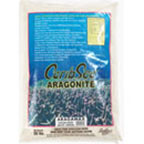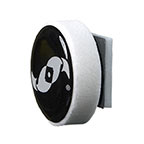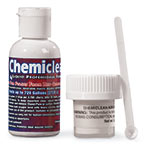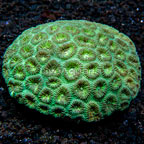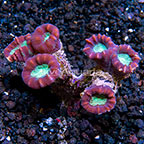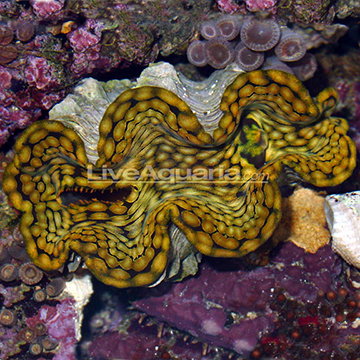

Additional locales and sizes may be available!
Additional locales and sizes may be available! Email me when availableQuick Stats
What do these Quick Stats mean? Click here for more information
What do these Quick Stats mean? Click here for more information
Overview
Tridacna squamosal have a very broad range in the wild and are found in Central and South Pacific, the Coral Sea, the Indo-Pacific through the Indian Ocean, and the Red Sea. They occupy coral reef habitats, commonly found living among live and dead stony corals of the genus Acropora at depths up to 50 feet. All of these clams entering the aquarium trade are cultured in the Central Pacific and South Pacific Ocean, and are primarily gold, brown, and yellow in coloration, occasionally having orange, green, or blue spots. The rarest color form of Tridacna squamosal is all blue, and this color form is rarely available in the aquarium trade, demanding a very hefty price.
Squamosa clams will arrive either unattached or attached to small pieces of substrate. They will normally attach to a solid surface within a week or so of being introduced into the aquarium. Once attached to a solid surface, never forcibly remove an attached clam from the substrate or rockwork, as lethal damage to their foot and other tissue will be inevitable. As a last resort, to remove a clam from a hard surface gently cut each byssal thread with a razor blade as close to the attachment point of the rock or solid surface, making sure not to slice or damage any tissue.
In the home aquarium, Squamosa Clams require moderate to high lighting to thrive as they contain the symbiotic algae called zooxanthellae, and receive the majority of their nutrition from the light through photosynthesis. Smaller T. squamosa that are 2" or less in size are much more sensitive to very intense lighting as their membrane is much thinner than larger specimens. For this reason, care should be taken to properly photo-adapt them to the existing reef aquarium lighting in a similar manner to newly introduced stony and soft corals. When adapting a new Squamosa Clam to very intense lighting, it is ideal to set them on a small rock or in a plastic dish with coarse substrate at the bottom of the aquarium. Over time, the clam can then be slowly moved up higher in the aquarium.
Tridacna clams are also filter feeders and constantly filter the water for small particulates. Squamosa Clams larger than 2" do not require supplemental feedings, but smaller T. squamosa that are less than 2" should be fed a phytoplankton or greenwater supplement several times per week if maintained in a nutrient poor reef aquarium.
Squamosa Clams are relatively hardy and less demanding than most other Tridacna species, and require moderate to intense lighting and good water flow in the home aquarium. Proper water chemistry is very important, and they will thrive when calcium levels of 380- 450 mg/L, alkalinity level of 8-11 dKH, and magnesium level of 1280-1350 ppm are maintained.
Looking for the best food to feed your Tridacna Clams?
We recommend:AlgaGen Acartia tonsa
AlgaGen Pseudodiaptomus pelagicus
AlgaGen Parvocalanus crassirostris
AlgaGen PhycoPure™ Reef Blend
AlgaGen Decap'd Brine™
AlgaGen Rotifers



